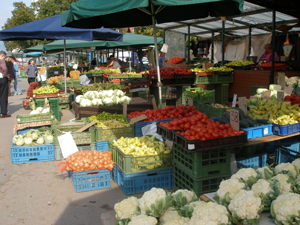 Outdoor market in Martin
Outdoor market in Martin
Sometimes our discoveries seem small, but the process involves so many
events that the day is quite busy and thus satisfactory. Such was the
case in Martin, where we had hoped to find some traces of Jewish ancestors,
but where we gained more of an understanding of the pace of life in town
and village.
 Outdoor market in Martin
Outdoor market in Martin
Knowing that the Jewish cemetery for the region had been in Martin, we asked
the hotel clerk if she knew where we could find it. She directed us to the
Information Center in downtown Martin, saying it was on the third floor of an
all-glass building. We parked in the municipal lot and walked through an
 The Information Center building
outdoor market which sold everything from clothing to fruits and vegetables to
flowers; as elsewhere, the majority of the flower arrangements (some real, some
artificial) were designed to be placed on gravestones.
The Information Center building
outdoor market which sold everything from clothing to fruits and vegetables to
flowers; as elsewhere, the majority of the flower arrangements (some real, some
artificial) were designed to be placed on gravestones.
We found a pedestrian tunnel leading to the central square, with underground
shops and a man playing a mournful accordion. The square itself was bustling
with activity. Some of the old buildings were being restored, while shoppers
trekked from one shop to the next. At the far end we found the Information
center which was just as impressive as the clerk had said.
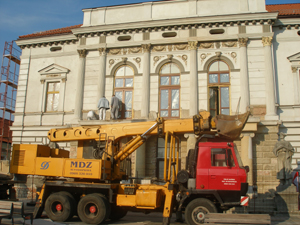 Restoring a building
Restoring a building
Martin is traditionally the intellectual and political heart of the movements for Slovak identity and independence. Matica slovenska, or Slovak Matrix, is an active organization that seeks to strengthen the Slovak language and culture; it is funded partly by the government and partly from private contributions. But to a tourist, Martin seems like a pleasant small city (pop. 60,000) with a history dating back to the 13th century, and a solid industrial base.
The Jewish cemetery consisted of a small plot of a few dozen graves near
the cemetery office. The stones were laid flat in the ground. We examined
all the stones, looking for ancestors, but as in Sarisske Sokolovce, we
 The Jewish Cemetery
found only distant cousins -- those with the same last name but not ancestors.
But a number of gravestones in this cemetery were inscribed only in Hebrew;
it is possible that the graves we were seeking were there all along.
The Jewish Cemetery
found only distant cousins -- those with the same last name but not ancestors.
But a number of gravestones in this cemetery were inscribed only in Hebrew;
it is possible that the graves we were seeking were there all along.
In Bardejov, we had seen a building with Hebrew writing, and the lady at the Greek Catholic church told us there were only three Jews left in Bardejov, and she indicated they would not appreciate a visit from inquisitive travelers. Nevertheless we inquired about a synagogue in Martin, and were told it had been destroyed. We read about a synagogue in the town of Vrutky, a suburb to the north of Martin, but that building was being used for some non-Jewish organizations.
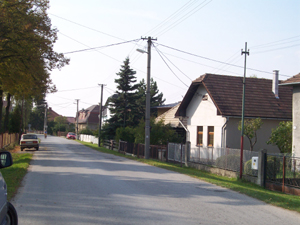 Main street in Pribovce
Leaving crowded Martin, we next stopped in the nearby village of Pribovce,
which was the nineteenth-century home of our Jewish ancestors. A tiny town,
Pribovce turned out to be incredibly old. We drove around unsuccessfully
looking for the town hall. When we inquired in the Post Office, the clerk
stopped her work and took us outside, pointing out the town hall. We had
not spotted the small official sign on the side.
Main street in Pribovce
Leaving crowded Martin, we next stopped in the nearby village of Pribovce,
which was the nineteenth-century home of our Jewish ancestors. A tiny town,
Pribovce turned out to be incredibly old. We drove around unsuccessfully
looking for the town hall. When we inquired in the Post Office, the clerk
stopped her work and took us outside, pointing out the town hall. We had
not spotted the small official sign on the side.
The mayor was not there when we arrived, but his assistant, a smiling woman,
telephoned her daughter who spoke some English. When they understood that
we had made a small scrapbook to give to the town library, they phoned the
mayor who hurried over to meet us. Once again, handshakes and smiles were
the order of the day. We presented our book to him and received in return a
beautiful history of Pribovce from its founding in 1230 to the present,
elegantly autographed by the mayor, with the town seal.
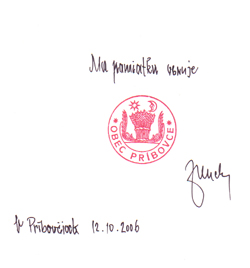 The mayor's inscription
The mayor's inscription
There was no place to eat in Pribovce, but in Vrutky we spotted a place
labeled BUFET, which our guide book had said was a good place to appreciate
local culture. It turned out to be a short-order place, without the benefit
of the fully-illustrated menus of a RESTAURACIA, and populated with a gang
of construction workers on their lunch break. It would have been an OK
choice if Bob had not become adventurous and spotted what he thought were
pickled herring, labeled "Baltic fish" in Slovak. They were indeed pickled
herring, but apparently the local custom is not to gut and clean the fish
before pickling! We all laughed as Bob swore never to eat in a BUFET again!
(The rest had a perfectly good roast pork luncheon.)
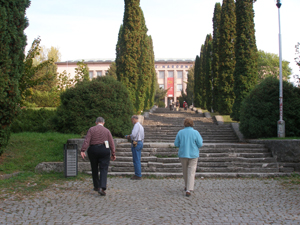 The museum in Martin
The museum in Martin
Afterward, to cheer Bob up, we found a store selling ZMRZLINA, which is really a Slovak word one should learn -- it means ice cream, somewhat like gelato, and sold everywhere in the country for 5 crowns (about 17 cents) per scoop.
We decided to visit the Slovak National Museum in Martin, which turned out to be a disappointment after the wonderful museum in Svidnik. To be fair, they were preparing for the opening the next day of a major new exhibit on the Slovak theater, and museums tend to get rattled as the opening day of a new exhibition grows close. But the permanent collections were hidden behind closed (and sometimes locked) doors, and the few items on display were poorly described in any language.
Despite its illustrious past, Martin came across to us as a less-than-charming industrial town, without the brilliance that we felt in Eastern Slovakia. We looked forward to better sightseeing in Bratislava.